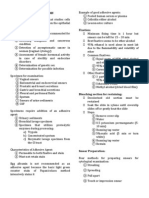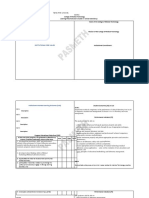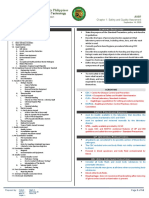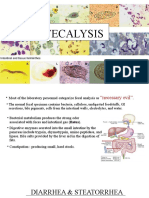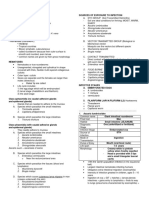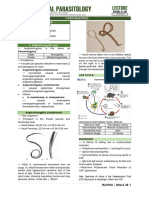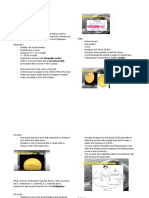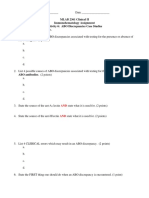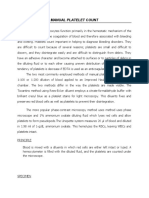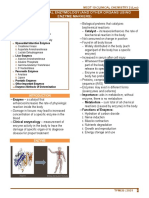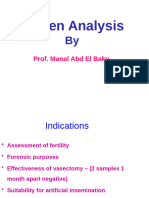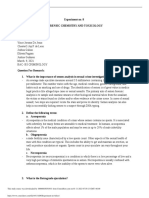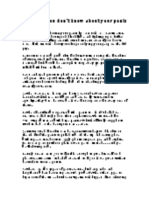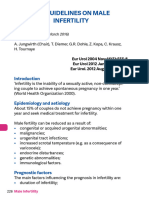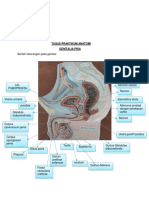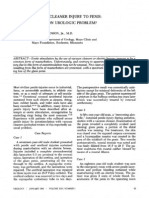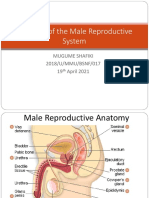AUBF Lecture Module 8 Chapter 10: SEMINALYSIS: Semen Analysis
AUBF Lecture Module 8 Chapter 10: SEMINALYSIS: Semen Analysis
Uploaded by
Colene MoresCopyright:
Available Formats
AUBF Lecture Module 8 Chapter 10: SEMINALYSIS: Semen Analysis
AUBF Lecture Module 8 Chapter 10: SEMINALYSIS: Semen Analysis
Uploaded by
Colene MoresOriginal Title
Copyright
Available Formats
Share this document
Did you find this document useful?
Is this content inappropriate?
Copyright:
Available Formats
AUBF Lecture Module 8 Chapter 10: SEMINALYSIS: Semen Analysis
AUBF Lecture Module 8 Chapter 10: SEMINALYSIS: Semen Analysis
Uploaded by
Colene MoresCopyright:
Available Formats
AUBF Lecture Module 8 Chapter 10: SEMINALYSIS
SEMEN ANALYSIS
- fluid from males
- contains semen, necessary for reproduction
- FOUR FRACTIONS OF SEMEN:
» Testes and epididymis: sperm cell itself; sperm cells- majority found on the very first
part of semen (pre-cum)
» Seminal vesicles: causes the semen to become alkaline
Important to become an alkaline to neutralize the acidity of the pH within the
vagina
» Prostate: acidity of semen
» Bulbourethral glands
- Major contribution of semen comes from the seminal vesicles and prostrate
- SEMEN COMPOSITION:
Seminal fluid: 60-70%
Prostate fluid: 20-30%
Spermatozoa: 5%
Bulbourethral glands: 5%
- The mixing of all four fractions during ejaculation is essential for the production of a
normal semen specimen
EXAMINATION OF SEMEN:
1. For fertility testing
2. Evaluate the effectiveness of vasectomy – 2 weeks to 1 month post vasectomy (no
sperm or viable sperm in semen sample)
3. Investigation of sexual assault cases – rape cases
> Surface of female genitalia [acid phosphates (prostatic fluid from semen) and prostate
specific antigen (from prostatic fluid)] = sexual contact
Seminal fluid and sperm – only a component of semen
SPERMATOZOA
- produced in the seminiferous tubules of the testes
- They mature and are stored in the epididymis
- spermatozoa and fluid from the epididymis contribute about 5% of the semen volume
SEMINAL VESICLES
- produce the majority of the fluid present in the semen (70%)
- the fluid contains high content of fructose (carbohydrate being utilize for energy
purposes) that the spermatozoa readily metabolize
- spermatozoa do not become motile until they are exposed to the fluid from the seminal
vesicle
AUBF Lecture Module 8 Chapter 10: SEMINALYSIS
PROSTATE GLAND
- 20 to 30% of the semen volume is acidic fluid
- the fluid contains high concentrations of acid phosphates, citric acid, zinc and proteolytic
enzymes responsible for both the coagulation and liquefaction of the semen following
ejaculation
BULBOURETHRAL GLANDS
- contribute about 5% of fluid volume in the form of a thick, alkaline mucus that helps
neutralize acidity from the prostate secretions and the vaginal acidity.
SPECIMEN HANDLING
- majority of the sperm are contained in the first portion of the ejaculate (pre-cum)
- should be abstinence 3 days and not longer than 5 days
» Prolonged abstinence – higher volumes and decreased motility (bc long abstinence
means more dead sperm cells); longer liquefaction time
» Short abstinence – low volume, low sperm count
- fertility testing: 2-3 samples within 2-week interval
» 2 samples with abnormal results = infertility
- provide an area where collection is possible; not normal comfort room but it should
resemble the environment at home to let the patient comfortable and not affect the
quality of the specimen
- laboratory should provide warm sterile glass or plastic containers
- specimen should be kept at room temperature and deliver to the laboratory within 1 hr
of collection
- fresh specimen is clotted and should be liquefy within 30-60 min after collection
(colloidal suspension; more liquid)
- specimen awaiting analysis should be kept at 37C
- specimen should be collected by masturbation. If not possible, only non-lubricant
polymeric silicone (silastic) condoms should be used
- specimen are potential reservoirs of HIV and hepa virus
- specimen are discarded as biohazardous wastes
» biohazardous waste: yellow
» non-hazardous solid waste: black
» non-hazardous biodegradable: green
3 METHODS OF COLLECTION
1. Induce ejaculation by masturbation: most preferred
2. Coitus interruptus (withdrawal): sexual act, not preferred bc the pre-cum is already lost
which contains most number of sperm cells; very low sperm count
3. Use of condoms: not preferred; condoms should be free from lubricants, which are
spermicidal (kill the sperm cells)
AUBF Lecture Module 8 Chapter 10: SEMINALYSIS
SEMEN ANALYSIS
NORMAL VALUES FOR SEMEN ANALYSIS
Volume 2-5 ml
(extended period of abstinence = greater
volume
Viscosity pours in droplets (already liquefied)
(aspirate in disposable pipette, 2cm)
(bigger than 2cm = more viscous)
pH 7.2-8.0
(greater pH = there is infection within male
genitalie)
(less than 7.2 = there is a greater
contribution from prostate, indicate poorly
developed seminal vesicles)
Sperm concentration >20 millions
Motility >50% within 1hr
Quality >2.0
Morphology >14% normal forms (strict criteria)
= there are more parameters to consider
>30% normal forms (routine criteria)
WBC <1.0 million/ml
(greater = infection or inflammation)
APPEARANCE
- Gray-white color, translucent, musty or bleach like odor
- Increased turbidity = presence of WBC and infection within the male genital tract
- WBCs must be differentiated from immature sperm (spermatids)
- Leukocyte esterase reagent strip = useful to screen the presence of WBCs
- Red color = presence of RBC and abnormal; indicate that there is a breakage in
barrier of testes and blood vessel
- Yellow color – urine contamination; prolonged abstinence and medications
- urine is toxic to the sperm = affecting the evaluation of motility
VOLUME
- Can be measured by pouring it into graduated cylinder calibrated 0.1 ml increments
- Increased volume = extended abstinence
- Decreased volume = infertility and may indicate improper functioning of semen
producing organs (seminal vesicles of prostate glands)
- Incomplete liquefied = clumped and highly viscous; affect the motility of the sample
AUBF Lecture Module 8 Chapter 10: SEMINALYSIS
- Normal semen specimen should be easily drawn from the pipette and from droplets that
do not appear clumped of string when discharged from the pipette
- Ratings of 0 (watery) to 4 (gel-like)
pH
- Increased pH = infection within male reproductive tract
- Decreased pH – increased prostatic fluid or decrease in the contribution of seminal
vesicles
- Semen for pH testing can be applied to the pH pad of a urinalysis reagent strip and the
color compared to the manufacturer’s chart
- Dedicated pH testing paper can also be used
- Urine reagent – pH, WBC, RBC
SPERM CONCENTRATION
- perfomed using the Newbauer counting chamber
- counted in the same manner as CSF count, that is by diluting the specimen and counting
the cells in the Newbauer chamber
- the most commonly used dilution is 1:20 prepared using a mechanical rather than a
Thoma pipette (positive displacement pipette)
- Diluting = immobilize sperm
- Traditional diluting fluid = sodium bicarbonate and formalin, which immobilize and
preserve the cells; however good results can also be achieved using tap water (chilled
water)
- The Makler counting chamber provides a method for counting undiluted specimen using
a counting chamber with 1mm2 grid divided into 100 squares engraved in the cover
plate
- Sperm = immobilized by heating part of the specimen prior to charging the chamber
- Sperm motility – using the unheated portion of the chamber
- Using the Newbauer, sperms are usually counted in the four corner and center squares
of the large center square
- Both sides are loaded and counted and the counts should agree within 10%
Ex. 230 + 10%
230 x .10 = 23
230 – 23 = 207
230 + 23 = 253
Range between 207 -253
- Only fully developed sperms should be counted
AUBF Lecture Module 8 Chapter 10: SEMINALYSIS
- Immature sperms and WBCs are often referred to as ‘round cells’ must not be included
- The presence of round cells may be significant and they may need to be identified and
counted separately
- Counting chamber
» Only small number of sperm cells = 4 corner large squares
» Routine procedure – 5 medium squares of central large square
FORMULAS:
𝒔𝒑𝒆𝒓𝒎𝒔 𝒄𝒐𝒖𝒏𝒕𝒆𝒅 𝒙 𝟐𝟓 𝒙 𝟏𝟎 𝒙 𝒅𝒊𝒍𝒖𝒕𝒊𝒐𝒏 𝒇𝒂𝒄𝒕𝒐𝒓
𝑺𝒑𝒆𝒓𝒎 𝒄𝒐𝒏𝒄𝒆𝒏𝒕𝒓𝒂𝒕𝒊𝒐𝒏/𝒖𝑳 =
# 𝒐𝒇 𝒎𝒆𝒅𝒊𝒖𝒎 𝒔𝒒𝒖𝒂𝒓𝒆𝒔 𝒄𝒐𝒖𝒏𝒕𝒆𝒅 𝒊𝒏
𝒔𝒑𝒆𝒓𝒎𝒔 𝒄𝒐𝒖𝒏𝒕𝒆𝒅 𝒙 𝟏𝟎 𝒙 𝒅𝒊𝒍𝒖𝒕𝒊𝒐𝒏 𝒇𝒂𝒄𝒕𝒐𝒓
𝑺𝒑𝒆𝒓𝒎 𝒄𝒐𝒏𝒄𝒆𝒏𝒕𝒓𝒂𝒕𝒊𝒐𝒏/𝒖𝑳 =
# 𝒐𝒇 𝒍𝒂𝒓𝒈𝒆 𝒔𝒒𝒖𝒂𝒓𝒆𝒔 𝒄𝒐𝒖𝒏𝒕𝒆𝒅 𝒊𝒏
𝑺𝒑𝒆𝒓𝒎 𝒄𝒐𝒖𝒏𝒕/𝒆𝒋𝒂𝒄𝒖𝒍𝒂𝒕𝒆 = 𝒔𝒑𝒆𝒓𝒎 𝒄𝒐𝒏𝒄𝒆𝒏𝒕𝒓𝒂𝒕𝒊𝒐𝒏/𝒎𝑳 𝒙 𝒗𝒐𝒍𝒖𝒎𝒆 𝒐𝒇𝒔𝒂𝒎𝒑𝒍𝒆
Convert microliter to millilitre – multiply 1000
PROBLEMS:
343 sperm cells were counted in 5 medium squares of the central large square on one side of
the INCC. 253 sperm cells were counted on the other. Compute for sperm concentration and
sperm count if the volume of the sample was 3.5mL.
253 x .10 = 25
253 – 25 = 228 253 + 25 = 278
343 > 278
= invalid count
343 sperm cells were counted in 5 medium squares of the central large square on one side of
the INCC. 325 sperm cells were counted on the other side. Compute for sperm concentration
and sperm count if the volume of the sample was 3.5mL.
325 x .10 = 32
325 – 32 = 293 325 + 32 = 357
343 < 357
AUBF Lecture Module 8 Chapter 10: SEMINALYSIS
𝒔𝒑𝒆𝒓𝒎𝒔 𝒄𝒐𝒖𝒏𝒕𝒆𝒅 𝒙 𝟐𝟓 𝒙 𝟏𝟎 𝒙 𝒅𝒊𝒍𝒖𝒕𝒊𝒐𝒏 𝒇𝒂𝒄𝒕𝒐𝒓
𝑺𝒑𝒆𝒓𝒎 𝒄𝒐𝒏𝒄𝒆𝒏𝒕𝒓𝒂𝒕𝒊𝒐𝒏/𝒖𝑳 =
# 𝒐𝒇 𝒎𝒆𝒅𝒊𝒖𝒎 𝒔𝒒𝒖𝒂𝒓𝒆𝒔 𝒄𝒐𝒖𝒏𝒕𝒆𝒅 𝒊𝒏
(𝟑𝟒𝟑 + 𝟑𝟐𝟓) 𝒙 𝟐𝟓 𝒙 𝟏𝟎 𝒙 𝟐𝟎
𝑺𝒑𝒆𝒓𝒎 𝒄𝒐𝒏𝒄𝒆𝒏𝒕𝒓𝒂𝒕𝒊𝒐𝒏/𝒖𝑳 =
𝟏𝟎
(𝟑𝟒𝟑 + 𝟑𝟐𝟓) 𝒙 𝟐𝟓 𝒙 𝟏𝟎 𝒙 𝟐𝟎
𝑺𝒑𝒆𝒓𝒎 𝒄𝒐𝒏𝒄𝒆𝒏𝒕𝒓𝒂𝒕𝒊𝒐𝒏/𝒖𝑳 =
𝟏𝟎
𝑺𝒑𝒆𝒓𝒎 𝒄𝒐𝒏𝒄𝒆𝒏𝒕𝒓𝒂𝒕𝒊𝒐𝒏/𝒖𝑳 = 𝟑𝟑𝟒 𝟎𝟎𝟎/𝒖𝑳
𝑺𝒑𝒆𝒓𝒎 𝒄𝒐𝒏𝒄𝒆𝒏𝒕𝒓𝒂𝒕𝒊𝒐𝒏/𝒖𝑳 = 𝟑𝟑𝟒 𝟎𝟎𝟎 𝟎𝟎𝟎/𝒎𝑳
𝑺𝒑𝒆𝒓𝒎 𝒄𝒐𝒖𝒏𝒕/𝒆𝒋𝒂𝒄𝒖𝒍𝒂𝒕𝒆 = 𝒔𝒑𝒆𝒓𝒎 𝒄𝒐𝒏𝒄𝒆𝒏𝒕𝒓𝒂𝒕𝒊𝒐𝒏/𝒎𝑳 𝒙 𝒐𝒍𝒖𝒎𝒆 𝒐𝒇𝒔𝒂𝒎𝒑𝒍𝒆
𝑺𝒑𝒆𝒓𝒎 𝒄𝒐𝒖𝒏𝒕/𝒆𝒋𝒂𝒄𝒖𝒍𝒂𝒕𝒆 = 𝟑𝟑𝟒 𝟎𝟎𝟎 𝟎𝟎𝟎 𝒙 𝟑. 𝟓
𝑺𝒑𝒆𝒓𝒎 𝒄𝒐𝒖𝒏𝒕/𝒆𝒋𝒂𝒄𝒖𝒍𝒂𝒕𝒆 = 𝟏 𝟏𝟔𝟗 𝟎𝟎𝟎 𝟎𝟎𝟎 / 𝒆𝒋𝒂𝒄𝒖𝒍𝒂𝒕𝒆
SPERM MOTILITY
- progressive movement and motility = critical for fertility because once presented to the
cervix, the sperm must propel themselves through the cervical mucosa to the uterus,
fallopian tubes and ovum
- assessment of sperm motility should be performed in a well-mixed, liquefied specimen
within 1 hr of semen collection’
- SPERM MOTILITY GRADING
GRADE CRITERIA
4.0 Rapid, straight-line motility
3.0 Slower speed, some lateral movement
2.0 Slow forward progression, noticeable lateral movement
1.0 No forward progression
0 No movement
- Greater than 50% show grade 2 3 4 motility; less than that would be abnormal
SPERM MORPHOLOGY
- Head and tail appearance
- Acrosomal cap in head, 1 half of head
- Head abnormality = poor ovum penetration
- Tail abnormality – poor mortility
- Normal sperm – oval-shaped head approximately 5 um long and 3 um wide and a long,
flagellar tail approximately 45 um long
- Head and tail are connected by neck and the middle piece, which contains mitochondria
that provide energy for flagellar tail motion
- Should have 30% normal motility (relaxed/routine criteria)
AUBF Lecture Module 8 Chapter 10: SEMINALYSIS
- Acrosomal cap = with enzyme
- Sperm morphology is evaluated from a thinly smeared, stained slide under oil immersion
- Staining can be performed using Wright’s, Giemsa, or Papanicolaou Stain (Pap stain)
- Air-dried slides are stable for 24 hr
- Atleast 200 sperm should be evaluated and the percentage of abnormal sperm reported
(atleast 60 is normal in appearance to be considered normal)
ADDITIONAL TESTING
SPERM VIABILITY
- Decreases sperm viability may be suspected when a specimen has a normal sperm
concentration with markedly decreased motility (sperms are already dead)
- Viability is evaluated by mixing the specimen with eosin-nigrosin stain, preparing a
smear, and counting the no. of dead cells in 100 sperm
- Living cells – bluish white color
- Dead cells – red against a purple background
» stains the dead cells bc the living cells has an intact cell membrane
- Normal viability – 75% living cells, bluish white sperm in a purple background
SEMINAL FLUID FRUCTOSE
- specimens can be screened for the presence of fructose using Resorcinol test
- a normal quantitative level of fructose is equal to or greater than 13 umol/ejaculate
- specimens for fructose levels should be tested within 2 hrs or frozen to prevent
fructolysis
- Fructose = carbohydrate for energy needs
ANTI SPERM ANTIBODIES
- can be present in both men and women
- may be detected in semen, cervical mucosa, or serum and are considered possible
causes of infertility
- male anti-sperm antibodies = more frequently encountered
- when the blood-testes-barrier is disrupted, as can occur following surgery, vasectomy,
reversal, trauma, and infection, the antigens of the sperms produce an immune
response that damages the sperm
- present following an infection of genital tract
- (+) Ab in male partner: clumps of sperm during routine analysis
- (+) Ab in female partner: normal semen analysis accompanied by continued infertility.
Mixing the semen with the cervical mucosa and observing agglutination of semen with
cervical mucosa or serum of female
AUBF Lecture Module 8 Chapter 10: SEMINALYSIS
TWO FREQUENTLY USED TESTS
- MAR Test
» Used to detect the presence of IgG antibodies
» (+) microscopically visible clumps of sperms and particles or cells
» Less than 10% of the motile sperm attached to the particles is considered normal
- Immunobead Test
» More specific procedure
» Detect the presence of IgG, IgM, and IgA and will demonstrate what area of the
sperm is affected
» Presence of beads on less than 20% of the sperm is normal
ADDITIONAL TESTING FOR ABNORMAL SEMEN ANALYSIS
ABNORMAL RESULT POSSIBLE ABNORMALITY TEST
Decreased motility with Viability Eosin – nigrosin stain
normal count
Decreased count Lack of seminal vesicle Fructose level
support medium
Decreased motility with Male anti-sperm antibodies MAR & Immunobead test
clumping Sperm agglutination with
male serum
Normal analysis with Female anti-sperm antibodies Immunobead test
continued infertility Sperm agglutination with
female serum
MICROBIAL AND CHEMICAL TESTING
- Presence of more than 1 million leukocytes/mm = infection within the reproductive
frequently the prostate
- Routine aerobic and anaerobic cultures and tests for Chlamydia trachomatis,
Mycoplasma homilis, and Ureaplasma urealyticum are most frequently perfomed
» Infection = production of anti-sperm antibodies
- Additional chemical testing performed on semen may include determination of leves of
neutral a-glucosidase, zinc, citric acid, and acid phosphates.
- Decreased fructose = lack of seminal fluid
- Decreased neutral a-glucosidase = disorder of epididymis
- Decreased zinc, citrate, and acid phosphates = lack of prostatic fluid
NORMAL SEMEN CHEMICAL VALUES
Neutral a-glucosidase > 20mu/ ejaculate
Zinc > 2.4 umol/ ejaculate
Citric acid > 52 umol/ ejaculate
Acid Phosphatase > 200 u/ ejaculate
AUBF Lecture Module 8 Chapter 10: SEMINALYSIS
POST VASECTOMY SEMEN ANALYSIS
- Presence or absence of spermatozoa
- Specimens are routinely tested at months interval, beginning at 2 months post
vasectomy and continuing until consecutive monthly specimens shows no spermatozoa
- Examination of wet preparation using phase microscopy for the presence of motile and
non-motile sperm
- A negative wet preparation is followed by viability testing
SPERM FUNCTION TEST
TEST DESCRIPTION
Hamster egg penetration Sperms are incubated with species-
nonspecific hamster eggs and penetration is
observed microscopically
Cervical mucus penetration Observation of sperm penetration ability of
partner’s mid cycle cervical mucus
Hypo-osmotic swelling Sperm exposed to low sodium concentrations
are evaluated for membrane integrity and
sperm viability
In vitro acrosome reaction Evaluation of the acrosome to produce
enzymes essential for ovum penetration
You might also like
- AUBF LAB - Exams and QuizzesDocument18 pagesAUBF LAB - Exams and QuizzesLUALHATI VILLASNo ratings yet
- Histopath Transes 1Document9 pagesHistopath Transes 1Nico LokoNo ratings yet
- Compiled Quizes AubfDocument39 pagesCompiled Quizes AubfCharmaine BoloNo ratings yet
- Parasitology and Clinical MicrosDocument16 pagesParasitology and Clinical MicrosErvette May Niño MahinayNo ratings yet
- AUBF Notes 1Document9 pagesAUBF Notes 1ChiNo ratings yet
- RA 5527 & Amendments 2017-18Document50 pagesRA 5527 & Amendments 2017-18John Phillip Dionisio67% (3)
- Exfoliative CytologyDocument2 pagesExfoliative CytologyNathaniel Sim100% (2)
- CC1 CC3Document26 pagesCC1 CC3pikachuNo ratings yet
- Non-Enteric Gastrointestinal PathogensDocument11 pagesNon-Enteric Gastrointestinal PathogensOrhan AsdfghjklNo ratings yet
- Hema Transes 1Document13 pagesHema Transes 1Nico LokoNo ratings yet
- St. Paul University Philippines: College of Medical TechnologyDocument14 pagesSt. Paul University Philippines: College of Medical TechnologyJulius FrondaNo ratings yet
- MetabolismDocument58 pagesMetabolismZ ZernsNo ratings yet
- Histopathology P1 & P3Document16 pagesHistopathology P1 & P3Reizel GaasNo ratings yet
- Exercise 5 Hematocrit DeterminationDocument7 pagesExercise 5 Hematocrit DeterminationJam RamosNo ratings yet
- FECALYSISDocument14 pagesFECALYSISMarl Estrada100% (1)
- Lab Ex. 1 5Document5 pagesLab Ex. 1 5LUZVIMINDA GORDONo ratings yet
- Principles of MedtechDocument93 pagesPrinciples of MedtechAngel Cascayan Delos SantosNo ratings yet
- Bacte Lab - Prelim ExamDocument30 pagesBacte Lab - Prelim ExamDanielle Anne LambanNo ratings yet
- Fecal AnalysisDocument13 pagesFecal AnalysisYormae QuezonNo ratings yet
- Chapter 23 SummaryDocument4 pagesChapter 23 SummaryMartin ClydeNo ratings yet
- Manual AubfDocument4 pagesManual AubfNoraine Princess Tabangcora100% (2)
- Nematodes For Quiz 1 RevisedDocument6 pagesNematodes For Quiz 1 RevisedAra NuesaNo ratings yet
- Alvine Discharge DiseasesDocument1 pageAlvine Discharge DiseasesApril Rose AlivioNo ratings yet
- Ciulla MicrobiologyDocument30 pagesCiulla MicrobiologyskyereollNo ratings yet
- Kato Katz TechniqueDocument35 pagesKato Katz TechniqueJohn Paul Valencia100% (2)
- General Approach in Investigation of Haemostasis: Lecture 2: Bleeding TimeDocument28 pagesGeneral Approach in Investigation of Haemostasis: Lecture 2: Bleeding TimeClorence John Yumul FerrerNo ratings yet
- Glucose MethodologiesDocument3 pagesGlucose MethodologiesprincessNo ratings yet
- College of Medical Laboratory Science Our Lady of Fatima University-VelenzuelaDocument33 pagesCollege of Medical Laboratory Science Our Lady of Fatima University-VelenzuelaClaire GonoNo ratings yet
- WEEK 2 B Chemical Examination of Urine (Laboratory)Document9 pagesWEEK 2 B Chemical Examination of Urine (Laboratory)Dayledaniel SorvetoNo ratings yet
- Chapter 13 Rodaks HematologyDocument10 pagesChapter 13 Rodaks HematologyRALPH JAN T. RIONo ratings yet
- PMLS 2 Handling and Processing of Blood Specimens For LaboratoryDocument5 pagesPMLS 2 Handling and Processing of Blood Specimens For LaboratoryXyrelle NavarroNo ratings yet
- Clinical Parasitology Trans 07 Lecture PDFDocument14 pagesClinical Parasitology Trans 07 Lecture PDFSt. DymphaMaralit, Joyce Anne L.No ratings yet
- 2-Washing and Preparation of Red Cell SuspensionDocument9 pages2-Washing and Preparation of Red Cell SuspensionBromance H.No ratings yet
- Parasitology Lecture 4 - Atrial FlagellatesDocument4 pagesParasitology Lecture 4 - Atrial Flagellatesmiguel cuevasNo ratings yet
- Determination of HemolysisDocument3 pagesDetermination of Hemolysislindsay becudoNo ratings yet
- Echinostoma IlocanumDocument3 pagesEchinostoma IlocanumChristie Raye NapuliNo ratings yet
- CC - DAY 4 - PRE-TEST RationalizationDocument21 pagesCC - DAY 4 - PRE-TEST RationalizationVincent AmitNo ratings yet
- MTLBE Internship Assessment QuizDocument2 pagesMTLBE Internship Assessment QuizAngela LaglivaNo ratings yet
- Immuno Hema - EX 2 ACT - Veloso, Mary Raffaele G - BSMT 3DDocument3 pagesImmuno Hema - EX 2 ACT - Veloso, Mary Raffaele G - BSMT 3DAnneNo ratings yet
- #1 Glasswares: A. Plain Test TubesDocument3 pages#1 Glasswares: A. Plain Test Tubessansastark100% (3)
- Rumple LeedeDocument3 pagesRumple LeedeIrene Dewi Isjwara40% (5)
- (Hema) 1.1 Intro To Hema (Perez) - PANDADocument6 pages(Hema) 1.1 Intro To Hema (Perez) - PANDATony DawaNo ratings yet
- All in Trans Molecular BiologyDocument12 pagesAll in Trans Molecular BiologyCASTILLO, ANGELA ALEXA A.100% (1)
- Types of Culture Media (Bacteriology)Document5 pagesTypes of Culture Media (Bacteriology)Glydenne Glaire Poncardas GayamNo ratings yet
- MLAB 2361 Clinical II Immunohematology Assignment Activity 6: ABO Discrepancies Case StudiesDocument7 pagesMLAB 2361 Clinical II Immunohematology Assignment Activity 6: ABO Discrepancies Case Studiespikachu0% (1)
- Kato-Katz Method: LAVALLE, Jestin BDocument2 pagesKato-Katz Method: LAVALLE, Jestin BDixie DumagpiNo ratings yet
- Lab Activity No. 1 - Hemoglobin DeterminationDocument2 pagesLab Activity No. 1 - Hemoglobin DeterminationChelsea Padilla Delos ReyesNo ratings yet
- Analysis of Urine and Other Body FluidsDocument52 pagesAnalysis of Urine and Other Body FluidsJoseph VillamorNo ratings yet
- Manual Platelet CountDocument14 pagesManual Platelet CountMiyo SobremisanaNo ratings yet
- Stool Concentration MethodDocument2 pagesStool Concentration Methodqwshagdvndsavsb100% (1)
- Christian Villahermosa March 4, 2021: Philippine HIV and AIDS Policy ActDocument14 pagesChristian Villahermosa March 4, 2021: Philippine HIV and AIDS Policy ActvenusNo ratings yet
- Broad Spectrum Compatibility Test: Post-Lab DiscussionDocument18 pagesBroad Spectrum Compatibility Test: Post-Lab DiscussionMarj Mendez0% (1)
- Parasitology 1Document18 pagesParasitology 1christine delgado100% (2)
- Exercise 8Document4 pagesExercise 8Bishal KunworNo ratings yet
- MEDT 19 (Lec)Document17 pagesMEDT 19 (Lec)Erick PanganibanNo ratings yet
- 1 - Fixation2 0Document11 pages1 - Fixation2 0army rebelNo ratings yet
- WBC AnomaliesDocument20 pagesWBC AnomaliesJosephine Piedad100% (1)
- The politics of hunger: Protest, poverty and policy in England, <i>c.</i> 1750–<i>c.</i> 1840From EverandThe politics of hunger: Protest, poverty and policy in England, <i>c.</i> 1750–<i>c.</i> 1840No ratings yet
- 2013 Semen AnalysisDocument44 pages2013 Semen AnalysisNourhan MedhatNo ratings yet
- Chapter 10 - Semen Analysis (Written Report) by Paglinawan, Et Al.Document9 pagesChapter 10 - Semen Analysis (Written Report) by Paglinawan, Et Al.Martin Clyde100% (1)
- Abdul Qudus PatologiDocument37 pagesAbdul Qudus PatologiAgus SetiadiNo ratings yet
- Semen Analysis Corner Stone in Evaluating Infertility: MethodsDocument8 pagesSemen Analysis Corner Stone in Evaluating Infertility: MethodsHamid IqbalNo ratings yet
- Experiment No. 8Document2 pagesExperiment No. 8Jenny Acosta CatacutanNo ratings yet
- Aubf Lab M15 Seminal FluidDocument18 pagesAubf Lab M15 Seminal FluidNelly PeñafloridaNo ratings yet
- S5LT-IIa-1.1.1.1.a-Male Reproductive SystemDocument4 pagesS5LT-IIa-1.1.1.1.a-Male Reproductive SystemRhona Liza CanobasNo ratings yet
- 15 Things You Don't Know About Your PenisDocument2 pages15 Things You Don't Know About Your PenisBryan Wong100% (186)
- Bitacora Hospitalizacion LlenaDocument54 pagesBitacora Hospitalizacion LlenaburbujabombomNo ratings yet
- Pengaruh Penggantian Bovine Serum Albumin BSA DengDocument10 pagesPengaruh Penggantian Bovine Serum Albumin BSA DengRifqy YazidNo ratings yet
- Scrotum: Imp: Right Testicular TorsionDocument2 pagesScrotum: Imp: Right Testicular TorsionQuest Medinova Lab ManagerNo ratings yet
- Sperm Maturation in The Domestic CatDocument11 pagesSperm Maturation in The Domestic CatGeovanni LunaNo ratings yet
- ErectiondgdDocument3 pagesErectiondgdEr Mahavir MiyatraNo ratings yet
- Megaprepucio Tecnica CirurgicaDocument6 pagesMegaprepucio Tecnica CirurgicafelipediasedificacoesNo ratings yet
- Artificial Insemination in Humans and AnimalsDocument5 pagesArtificial Insemination in Humans and Animalsnoneivy anonymousNo ratings yet
- Semen AnalisisDocument16 pagesSemen AnalisisMia Sophia IrawadiNo ratings yet
- Bull Semen Collection and Analysis For ArtificialDocument11 pagesBull Semen Collection and Analysis For ArtificialAdleend RandabungaNo ratings yet
- AFP 2017 9 Focus Male InfertilityDocument6 pagesAFP 2017 9 Focus Male Infertilityfebyan yohanesNo ratings yet
- Spermatogenesis, Oligospermia & IUIDocument40 pagesSpermatogenesis, Oligospermia & IUIBibek GhimireNo ratings yet
- Yeny Elfiyanti - 1910070100082 - Tugas Praktikum Anatomi 2Document5 pagesYeny Elfiyanti - 1910070100082 - Tugas Praktikum Anatomi 2Yeny ElfiyantiNo ratings yet
- 13 Crucial Facts About Your PeniDocument3 pages13 Crucial Facts About Your PeniBelal AhmadNo ratings yet
- PenisDocument4 pagesPenisckiely91No ratings yet
- Dr. Bassem W. Yani, MD Diploma of Urology, FEBU, FCS, Cairo, EGYPT Consultant Urologist Uth Lusaka ZambiaDocument23 pagesDr. Bassem W. Yani, MD Diploma of Urology, FEBU, FCS, Cairo, EGYPT Consultant Urologist Uth Lusaka ZambiaMohammed AadeelNo ratings yet
- Adding Insult To Injury: Erectile Dysfunction and CircumcisionDocument3 pagesAdding Insult To Injury: Erectile Dysfunction and CircumcisionDanBollingerNo ratings yet
- Undescended TestesDocument29 pagesUndescended TestesHillary Bushnell100% (1)
- Male RepDocument3 pagesMale RepAdaha AngelNo ratings yet
- Anatomy of The Male Reproductive SystemDocument24 pagesAnatomy of The Male Reproductive SystemAbbasi KahumaNo ratings yet
- Abnormalities of The Testes and ScrotumDocument34 pagesAbnormalities of The Testes and ScrotumIma MoriNo ratings yet
- Artificial Insemination: TypesDocument3 pagesArtificial Insemination: Typessagi muNo ratings yet
- 19 Reproductive SystemDocument31 pages19 Reproductive Systemjohairah merphaNo ratings yet
- Inacbg (Nov 20)Document118 pagesInacbg (Nov 20)Risdiyanto AmisenoNo ratings yet
- Bailey Et Al., 2003. Semen Cryopreservation Successes and Persistent Problems in Farm SpeciesDocument10 pagesBailey Et Al., 2003. Semen Cryopreservation Successes and Persistent Problems in Farm SpeciesresaNo ratings yet






